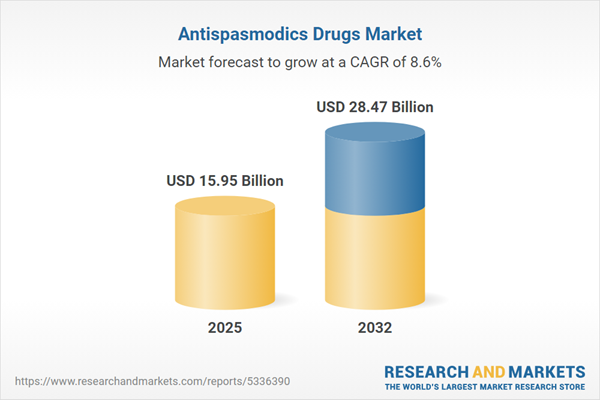Speak directly to the analyst to clarify any post sales queries you may have.
The antispasmodic drugs market is undergoing rapid transformation as healthcare organizations advance their operational and technology capabilities to stay ahead of shifting regulatory frameworks. Senior executives are prioritizing innovation and flexibility, paving the way for sustainable growth in a competitive global environment.
Market Snapshot: Antispasmodic Drugs Market
The global antispasmodic drugs market is expanding steadily, driven by a rising incidence of chronic gastrointestinal, urinary, and gynecological disorders. Sustained growth is attributed to heightened demand for adaptable treatment and care models, especially in regions with significant aging populations. Advances in drug delivery technology are facilitating new ways for healthcare organizations to improve competitive standing, even as regulatory policies evolve. Companies embracing innovation in therapy development and operational strategy are effectively navigating the complexities of reimbursement, care integration, and shifting patient needs.
Scope & Segmentation: Strategic Overview
This report provides executive leadership with actionable insights to fuel growth and achieve operational excellence within the antispasmodic drugs market. The comprehensive market evaluation covers factors essential for high-impact business planning:
- Formulations: Options include capsules, tablets, injectables, and syrups, giving clinicians flexibility to tailor treatment for diverse care settings and fostering patient-centered planning.
- Routes of Administration: Multiple pathways such as oral, parenteral, and topical enable providers to optimize patient adherence and support both inpatient and outpatient needs.
- Mechanisms of Action: Portfolio covers anticholinergic medications, calcium channel blockers, and GABA agonists, allowing for targeted strategies addressing varied symptom sets and demographics.
- Distribution Channels: Hospital pharmacies, retail outlets, and digital platforms increase therapeutic reach, securing access for patients at critical service points.
- Applications: Therapeutic uses span gastrointestinal, urinary, and gynecological conditions, supporting comprehensive care with integration across multiple specialties.
- End Users: Primary adopters are hospitals and clinics, which drive uptake, integration, and optimized care pathways across healthcare networks.
- Regions: Strategic approaches consider distinct regulatory and healthcare ecosystems in the Americas, Europe, Middle East and Africa, and Asia-Pacific, each shaping reimbursement practices and service delivery models.
- Leading Companies: The innovation landscape features Boehringer Ingelheim International GmbH, Sanofi S.A., Almirall S.A., Teva Pharmaceutical Industries Ltd., Viatris Inc., Sandoz International GmbH, Pfizer Inc., Dr. Reddy's Laboratories Limited, Sun Pharmaceutical Industries Ltd., and Glenmark Pharmaceuticals Limited.
Key Takeaways for Senior Executives
- Implementing advanced delivery systems such as nanotechnology and extended-release methods supports a risk-managed, adaptable portfolio as the market evolves.
- Accelerated digital health integration, including remote patient monitoring, increases operational efficiency and streamlines chronic disease management across care networks.
- Applying pharmacogenomics enables more precise, personalized treatment strategies tailored to complex patient profiles.
- Staying attuned to region-specific regulatory protocols and forging value-driven partnerships heightens organizational agility and resilience amid policy shifts.
- Strategically pursuing mergers, acquisitions, and targeted R&D activity enhances market adaptability as competitive and regulatory conditions change.
- Improving collaboration between procurement and care delivery teams optimizes supply chain performance, enhancing timely patient access throughout clinical systems.
Tariff Impact: United States 2025 Import Adjustments
New United States import tariff adjustments have increased costs for foundational raw materials used in antispasmodic drug manufacturing. Companies are responding with expanded supplier networks, upgraded production capabilities, and more formalized supplier contracts. This multi-pronged risk management approach sustains supply chain continuity and preserves productivity despite ongoing changes to trade and regulatory landscapes.
Methodology & Data Sources
This analysis is based on direct interviews with pharmaceutical procurement leaders, further supported by peer-reviewed literature and trusted industry databases. This comprehensive methodology ensures that executive decision-makers have dependable, actionable data for high-stakes planning.
Why This Report Matters
- Enables executives to proactively address risk, sharpen operational focus, and solidify competitive positioning in a complex, dynamic market.
- Guides innovation-focused expansion by highlighting emerging technologies, advanced delivery systems, and effective market segmentation.
- Promotes internal alignment with fast-evolving supply chain and regulatory requirements, empowering resilience across the pharmaceutical landscape.
Conclusion
Focused investment in new technologies, robust partnerships, and adaptive business models positions organizations to capture value and respond effectively to the evolving demands of the antispasmodic drugs market.
Additional Product Information:
- Purchase of this report includes 1 year online access with quarterly updates.
- This report can be updated on request. Please contact our Customer Experience team using the Ask a Question widget on our website.
Table of Contents
3. Executive Summary
4. Market Overview
7. Cumulative Impact of Artificial Intelligence 2025
Companies Mentioned
The companies profiled in this Antispasmodics Drugs market report include:- Boehringer Ingelheim International GmbH
- Sanofi S.A.
- Almirall, S.A.
- Teva Pharmaceutical Industries Ltd.
- Viatris Inc.
- Sandoz International GmbH
- Pfizer Inc.
- Dr. Reddy's Laboratories Limited
- Sun Pharmaceutical Industries Ltd.
- Glenmark Pharmaceuticals Limited
Table Information
| Report Attribute | Details |
|---|---|
| No. of Pages | 196 |
| Published | November 2025 |
| Forecast Period | 2025 - 2032 |
| Estimated Market Value ( USD | $ 15.95 Billion |
| Forecasted Market Value ( USD | $ 28.47 Billion |
| Compound Annual Growth Rate | 8.6% |
| Regions Covered | Global |
| No. of Companies Mentioned | 11 |









